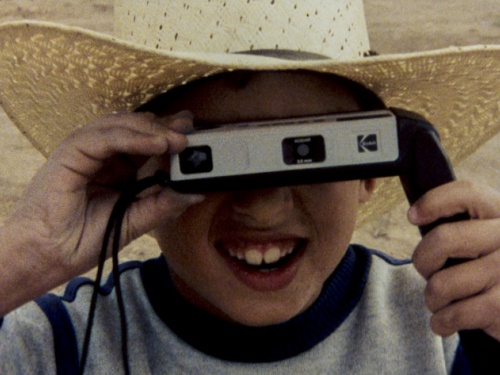Laugh or Cry: Jewish Humour in Chantal Akerman’s Histoires d’Amérique
Presented in partnership with film collective A Nos Amours, our Chantal Akerman retrospective continues with a screening of Histoires d'Amérique.
A Nos Amours co-founder Adam Roberts has written an evocative blog post on Akerman's homage to the jokes, stories, skits and silences of European Jewish culture in the film.
Chantal Akerman’s 1989 film Histoires d’Amérique, which Akerman herself subtitled in English as ‘Food, Family and Philosophy’, was not highly rated by Jonathan Rosenbaum:
Akerman is basically geared toward interiors, which may be one reason her latest feature, Food, Family and Philosophy, set mostly in exteriors, is not one of her strongest.
It is true that Akerman is brilliant when confronted by narrow doorways, small rooms, and constricted passageways. Her 1983 short film L’homme à la valise is a miracle of improvisation in an impossibly tight location. But to suppose that physical constraint is all that holds humans in bondage is surely a mistake. The weight of history, of a sense of dread, anxiety, or that annihilation is just around the corner are as real as walls, not least if you have fled pogrom and holocaust, or left behind those who were not so lucky as you.
To survive can be terrible.
Akerman begins Histoires with a shot of Manhattan across the water. Mist and fading light. The upper stories of the city’s skyscrapers are lost in the murk. The camera seems to stalk the city – an inversion of the view we had at the end of News From Home, the last film Akerman shot in New York, where the ferry from which she filmed was heading away from Manhattan. She provides the voice over:
A rabbi always passed through a village to get to the forest, and there, at the foot of a tree (and it was always the same one) he began to pray and God heard him. His son too always passed through the village but he could not remember where the tree was, and so he prayed at the foot of any old tree and God heard him. His grand-son did not know where the tree was, nor the forest, but went to pray in the village and God heard him. His great-grand-son did not know where the tree was, nor the forest, not even the village, but he still knew the words of the prayer, and so he prayed in his house and God heard him. His great-grand-son did not know where the tree, nor the forest, nor the village were, not even the words of the prayer, but he still knew the story and told it to his children; and God heard him.
These words set up what follows. The jokes, stories, skits and silences are the verbal survivals of European Jewish culture, cast up by diaspora on these shores, preserving certain forms of life in the shtetls and cities of the lost old world.
What to expect? Mordant wisdom, resignation, perky resistance and opportunism. The cast of the film are found on the streets and corners of their adopted run-down city (as it was then), eventually on an abandoned plot in Brooklyn, with the city lights of Manhattan in the distance. Shades of Waiting for Godot, shades of Isaac Bashevis Singer’s shtetl tales, shades of the badchen of the old country (the jesters hired to add vim to Ashkenazi weddings before Nazis put an end to that world).
Akerman recruited a varied cast, some professional comedians, some not. Some were old, some not. All are Jewish of the first and second generation. All have jokes, stories and anecdotal proof that something has persisted, something that defines has survived, despite loss and trauma and death.
Above all, Akerman’s acutely musical sense of time, rhythm and change is present. Her sense of when to cut, when not to cut, when to close in, when to hold back defines her method.
She is the most musical of filmmakers.
Shot on film—16mm intended to be printed onto 35mm stock—the negatives and all prints, Akerman tells us, are now lost. This Beta SP version is the surviving copy – a jaded video tape with French subtitles burned in (the sound track is in English, with Yiddish vocabulary thrown in ad lib). The survival of this film has become something in need of a prayer. ■
A Nos Amours: Chantal Akerman 13: Histoires d'Amérique screens 23 October, at 7pm.
This screening is part of what is believed to be the most complete retrospective ever attempted of Chantal Akerman's work, and is presented by film collective A Nos Amours.
This article is posted in: Blog, Film
Tagged with: A Nos Amours, Chantal Akerman, Histoires d’Amérique





